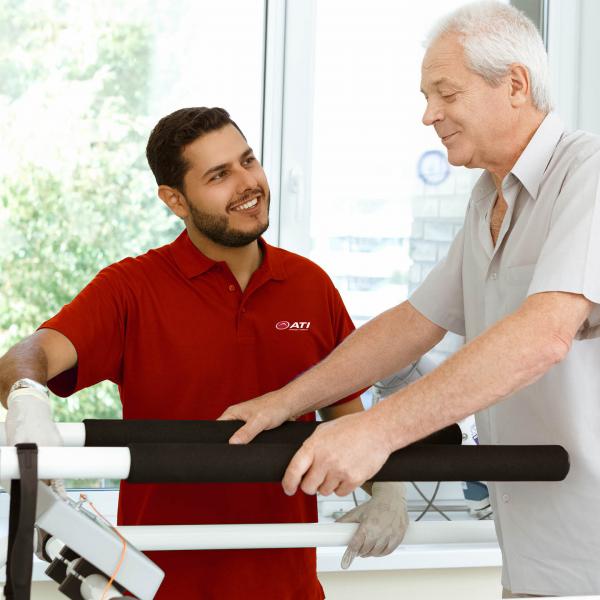
By: Hannah Fox, PT, DPT, SCS, ATC
Sitting has been termed the new smoking. Think about all the time spent sitting — commuting to and from work, at your desk for eight plus hours per day at work and eating dinner at home then crashing on the couch to watch TV. All the hours of inactivity add up. Making the change to add in more activity into your day can make huge improvements on your health. Every bit counts, and at ATI, we want you to know the benefits running has on your health with expert-backed tips to keep you on pace.
How movement affects your health
Leading a sedentary lifestyle can have detrimental effects to your health. The Annals of Internal Medicine posted a study linking sedentary time to increased hospitalizations, cancer, diabetes and cardiovascular disease. People who sat for prolonged periods were at a higher risk of dying from these diseases, even among those who exercised regularly. People who did not exercise at all were at the highest risk of these harmful diseases.
Dr. I-Min Lee, a professor of medicine at Harvard Medical School, found that you burn 30 percent more calories when you’re standing than when you’re sitting. Those calories add up quickly and can be a motivator for getting healthier and to move more often.
“Walking is the closest thing we have to a wonder drug,” says Dr. Thomas Frieden, director of the Centers for Disease Control and Prevention. Walking is a great way to bridge the gap and ease into exercise. It requires no equipment, you just have to get up and move. Even short boughs throughout the day are beneficial. You owe it to yourself to make movement a habit.
Exercise is a form of self-care. It is an investment in yourself and people who exercise live longer, heathier lives. Exercise helps decreased blood pressure, heart rate, cholesterol, weight and blood sugar. It improves vascular health, bone density, balance and sleep quality and may even improve your overall mood. It is also proven to help with cognition, including memory, attention and processing speed. In its purest form, exercise is medicine and is just as effective as many medications that can transform your life.
How much should you exercise?
The American Heart Association recommends 150 minutes of moderate-intense activity or 75 minutes of vigorous activity throughout the week to promote health and decrease risk of chronic disease. Moderate-intensity aerobic activities include brisk walking (at least 2.5 mph), water aerobics, dancing tennis and leisurely biking. Vigorous activities include hiking uphill, running, swimming, jumping rope and biking (greater than 10 mph).
For those who want to transition to a more vigorous exercise program, running is a great option. Like walking, you don’t need any equipment other than a good pair of shoes. When starting a running program, you should use walk/run intervals to allow your body to adapt to new stress. Run for time rather than a set distance. Once you have a good aerobic base, you can play around with different speeds and distances.
The Journal of American College of Cardiology conducted a study which followed 55,137 people over a 15-year period to determine the association of running and cardiovascular mortality risks. The study found that compared to non-runners, runners had 30 to 45 percent lower adjusted risks of all causes and cardiovascular mortality risks and even had a three-year life expectancy benefit. How much running was needed to reduce risks? Weekly running less than 51 minutes, less than 6 miles, 1-2 times or less than 6 mph was sufficient enough to reduce the risk of mortality, compared to not running. This activity can be translated to running about 5-10 minutes per day.
Tips to keep you on pace
You don’t have to go fast or far to reap the benefit of running. Reducing your risk of dying from cardiovascular disease starts with movement and it only takes 21 days to form a habit and two months to make a lifestyle change. Small, consistent changes over time lead to results. Sometimes the hardest part is getting started and putting your foot out the door. Movement is medicine and it can transform your life. Consider these tips so you can start moving and stay on pace to accomplish your goals:
- Set a goal for weekly fitness
- Be consistent — make movement a priority each day
- Use your phone or watch to track daily steps
- Walk at lunch time
- Set an alarm every hour to get up and walk five minutes
- Walk during TV commercials
- Stand while talking on the phone
Are aches and pains getting in the way of your daily activities or from starting an exercise program?
Stop by your nearest ATI Physical Therapy clinic for a complimentary screening and get back to doing you. Our experts will listen to your concerns, evaluate your injury and create a safe and effective plan to help you reach your goals and live a healthy, active lifestyle.
